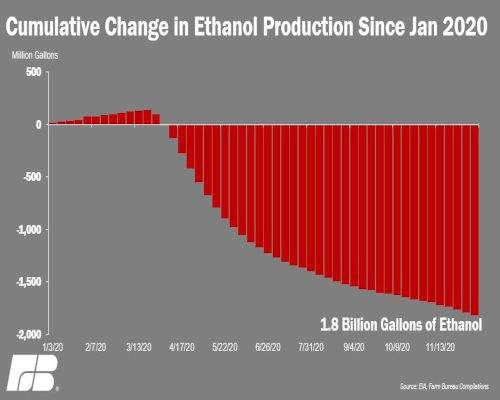Price Trigger and Flat Rate Crops
The bill provides approximately $11.2 billion of direct financial assistance to commodity producers. Producers of 2020 price trigger crops and flat-rate crops are eligible to receive a payment of $20 per eligible acre of the crop. Price trigger commodities, as defined in the second Coronavirus Food Assistance Program, are major commodities that meet a minimum 5% price decline over a specified period. These crops include barley, corn, sorghum, soybeans, sunflowers, upland cotton and all classes of wheat. For example, with 91 million acres of corn planted in 2020, and based on a $20 per acre payment, corn producers would be expected to receive $1.8 billion in financial support. Across these seven crops alone, 240 million acres were planted, representing $4.8 billion in COVID-19 stimulus. Additionally, the bill allows the Agriculture Secretary to extend the term of marketing loans by three months, providing producers additional time to repay.

Flat-rate crops, as described in CFAP 2, either do not meet the 5% price decline trigger or do not have data available to calculate a price change. Flat-rate crops include alfalfa, amaranth grain, buckwheat, canola, extra long staple (ELS) cotton, crambe (colewort), einkorn, emmer, flax, guar, hemp, indigo, industrial rice, kenaf, khorasan, millet, mustard, oats, peanuts, quinoa, rapeseed, rice, sweet rice, wild rice, rye, safflower, sesame, speltz, sugar beets, sugarcane, teff, and triticale. These commodities will also receive a payment of $20 per acre.
The bill includes a provision allowing for the adjustment of direct support payments to account for price differentiation among commodities. This may include specialized varieties, local markets and farm practices such as certified organic.
For specialty crop producers, the bill modified the sales-based rules from CFAP 2 to allow specialty crop producers to include crop insurance indemnities and disaster payments in their 2019 sales, which was the basis for determining the amount of support under CFAP 2, or by substituting 2018 sales. Additionally, the bill makes available an additional $100 million in Specialty Crop Block Grants that are administered through each state’s Department of Agriculture and an additional $100 million available for the Local Agriculture Market Program.
Assistance for Processors
The bill requires that a portion of the appropriated money to be used to make payments to domestic users of upland cotton and extra long staple cotton between March 1, 2020, and December 31, 2020. The payment rate is calculated by multiplying 6 cents per pound by the average monthly consumption of the domestic user from January 1, 2017, through December 31, 2019, then multiplying it by 10, e.g., cotton payment = $0.60 x (avg. monthly consumption Jan 1, 2017-Dec 31, 2019).
Moreover, one of the consequences of COVID-19 precautions and stay-at-home orders was a significant decrease in fuel consumption, and along with it was a slash to biofuel demand. Since the beginning of the year, and through mid-December, the cumulative decline in ethanol production is nearly 2 billion gallons. The bill allows for payments to producers of advanced biofuel, biomass-based diesel, cellulosic biofuel, conventional biofuel, or renewable fuel due to unexpected market losses as a result of COVID-19.

Fisheries Disaster Assistance
For offshore aquaculture producers, there is an additional $300 million in Fisheries Disaster Assistance available until September 30, 2021, for the Sec. 12005 CARES Act assistance program. In the CARES Act, an initial $300 million in direct assistance was provided to fisheries that were negatively impacted by COVID-19, including commercial fishing businesses, charter/for-hire fishing businesses, qualified aquaculture operations, processors and other fishery-related businesses, e.g., The Ins and Outs of Direct Assistance for Fisheries. The provisions for distributing the money among eligible states are specifically outlined in Sec. 12005 of the CARES Act and are updated by the Commerce Department’s National Oceanic and Atmospheric Administration. This additional money will be appropriated to eligible states, tribes or territories and limits the amount each government entity can receive based on the total annual average revenue generated to the state from commercial fishing operations, aquaculture firms, the seafood supply chain and charter fishing businesses.
Timber Harvesting and Hauling
For timber harvesting and timber hauling businesses, $200 million is allocated for relief to those that experienced a loss of at least 10% of gross revenue between January 1, 2020, through December 1, 2020, compared to the gross revenue earned in the same period in 2019.
Livestock and Dairy Provisions
Support to Contract Growers of Livestock and Poultry
Poultry, in particular, was left out of the CARES Act, largely due to the structure of the industry and how the relationship between the farmer and integrator historically has operated. Under the CARES Act, to be eligible for assistance, the farmer had to directly own the commodity. This worked well for MOST cattle and hog producers, but not for broiler farmers. Typically, a broiler farmer raises and cares for the birds, but does not directly own the birds; the integrator maintains ownership of the animals. However, these producers saw their income significantly reduced as many of their barns (which they financed the construction of and still were required to service the debt) remained empty due to supply chain disruptions earlier in the pandemic. The new bill addresses losses faced by many in the poultry industry (and other livestock sectors as well) by providing $1 billion for contract growers of livestock and poultry to cover up to 80% of losses.
Support for Losses Due to Depopulation of Animals
The livestock supply chain was significantly disrupted, especially at processing facilities, where labor shortages and worker protection measures slowed throughput and even caused some facilities to shut down. As a result, some producers were forced into the heart-wrenching position of having to euthanize their animals. This is the last resort, as farmers do everything they can to avoid this outcome, but in such a tightly coupled delivery system they were threatened with going out of business having raised animals they could no longer sell. This bill directs the Agriculture Secretary to make payments to producers for losses incurred due to the depopulation of livestock and poultry due to insufficient processing access. These payments will be up to 80% of the fair market value of the depopulated animals, and for the costs of depopulation.
Livestock Dealer Statutory Trust
The bill ensures that livestock producers are paid for their animals by requiring dealer trusts. In the current system, dealers frequently buy and resell livestock, often grouping them to meet the volume and type needs of their customers. Dealers are allowed to take possession of livestock and pay for them later, and dealers do not maintain a trust account to guarantee payment.
Click here to see more...